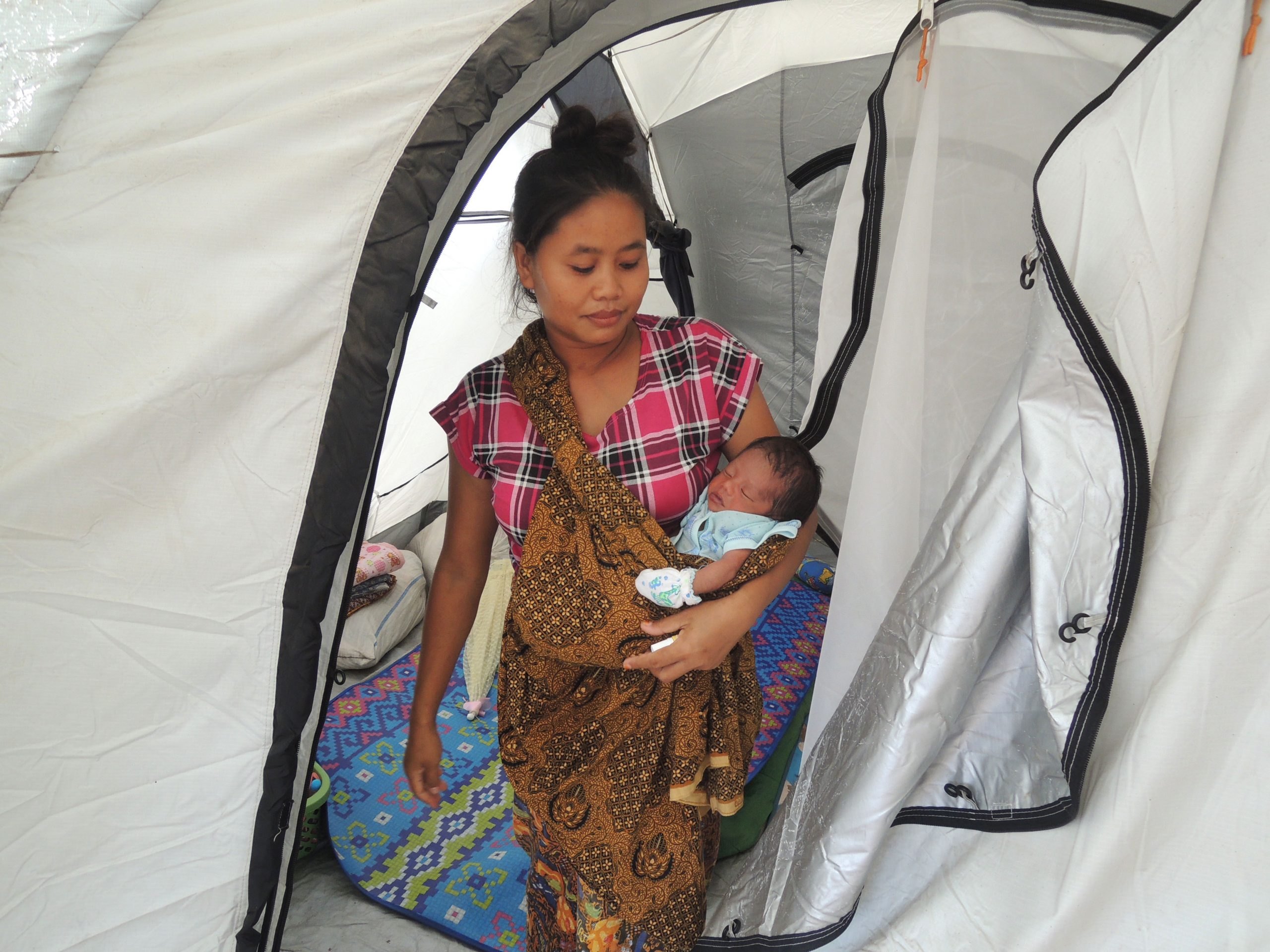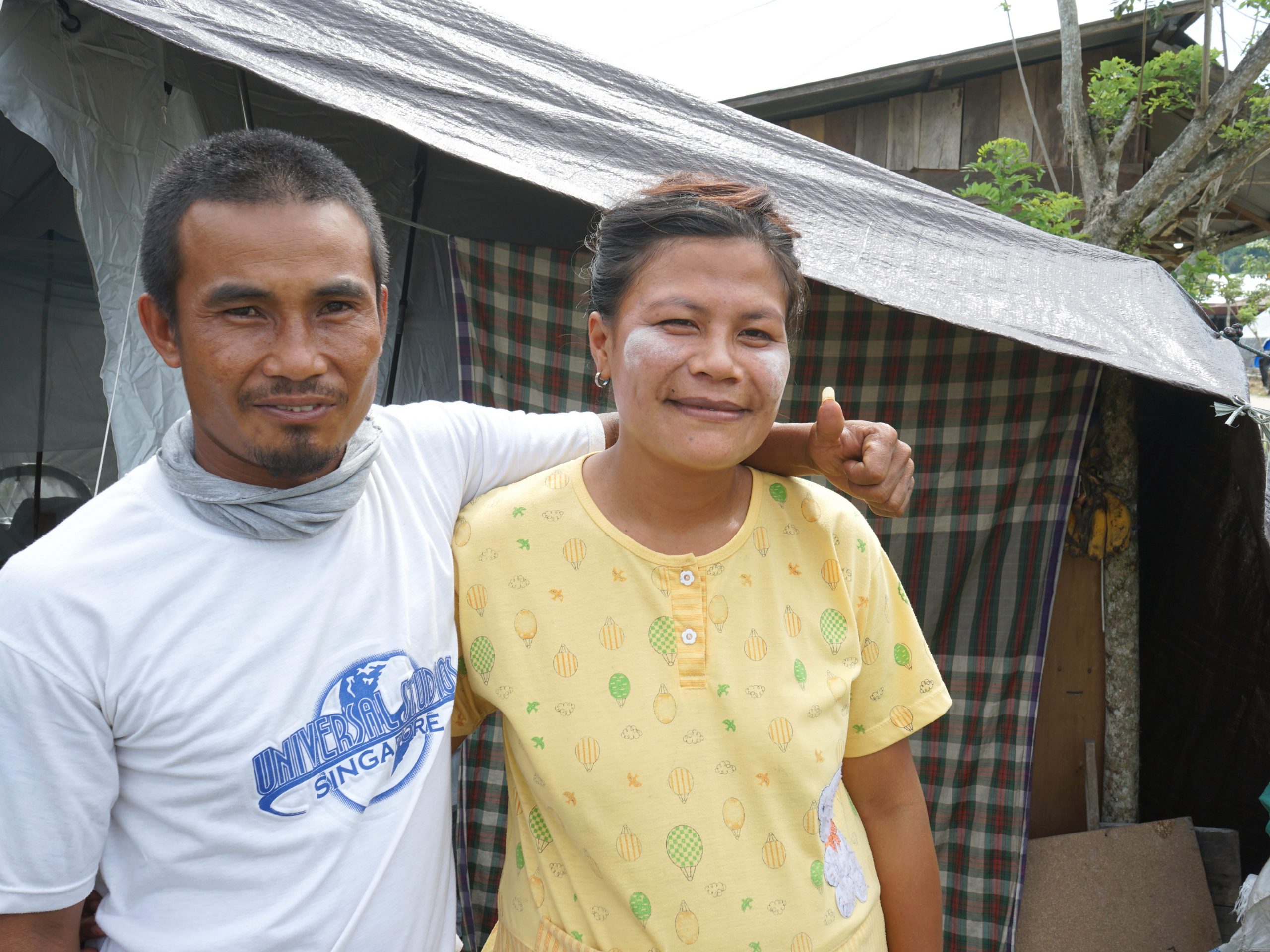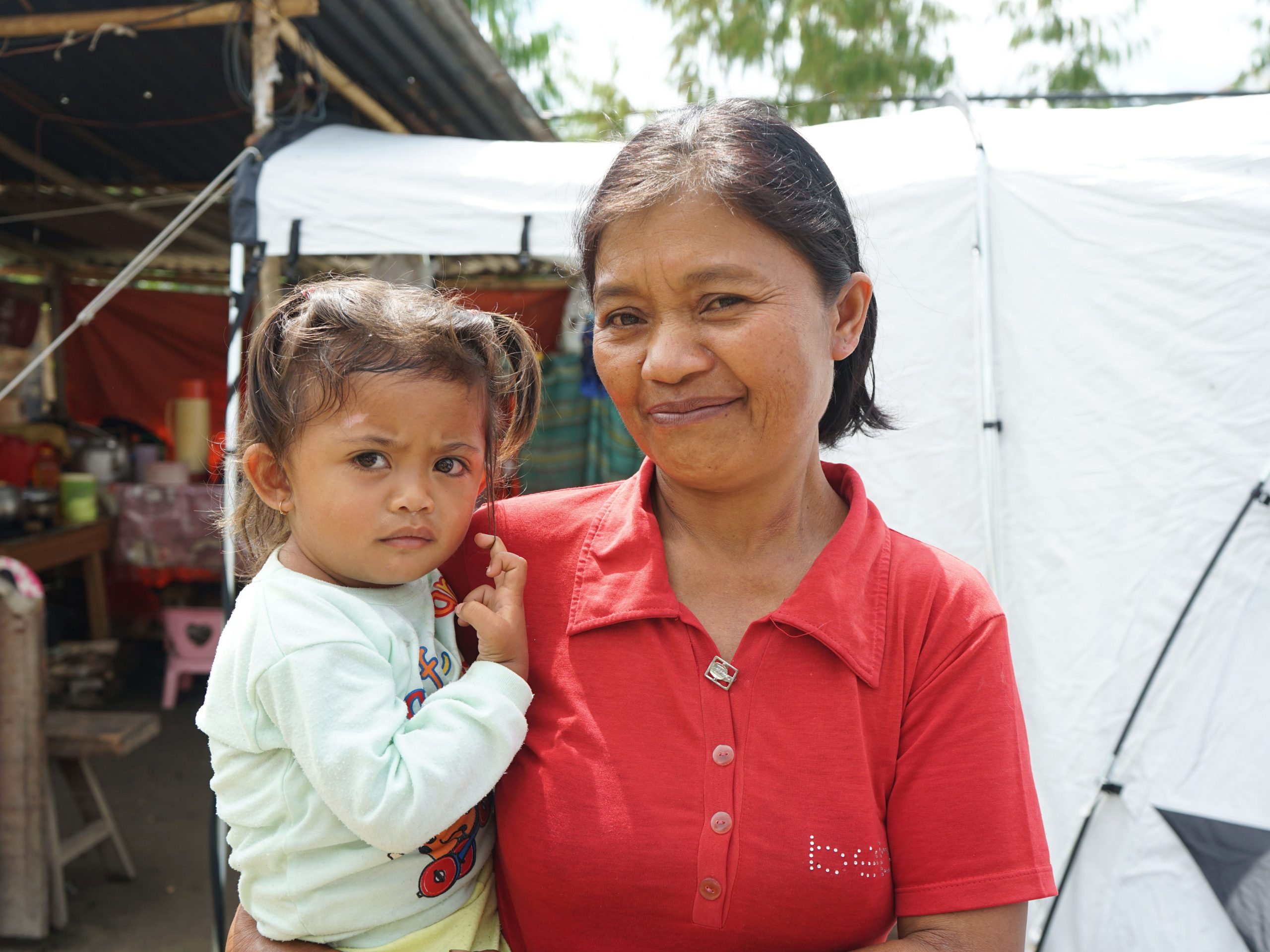
YOUR AID IN ACTION - Distribution Updates
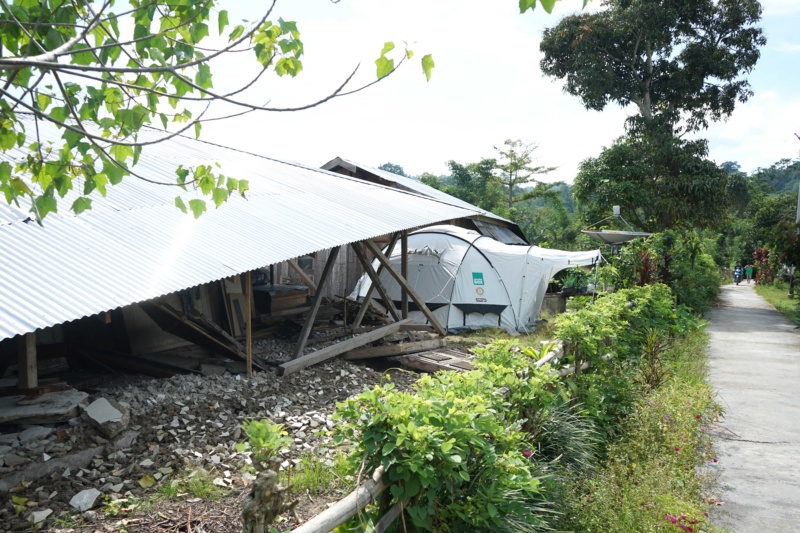
Thanks to your support ShelterBox Response Teams were able to travel to remote communities near Sulawesi that were affected by the earthquake and tsunami. The community
reached was so remote that access was only possible by helicopter! Thanks to your support teams were able to go where no one else would to deliver your aid to families.
620 families received aid following the tsunami including family tents, mosquito nets, water carriers, and water filters. Additionally, families were provided with extra rope and tarp packages.
Thanks to you, families feel safe in their new temporary homes
The tent is nice, we feel very comfortable and we get a good night’s sleep now. Not too hot, not too cold. We feel safe… And no more mosquitoes!”
How YOU made a difference
Earthquake and tsunami devastate Indonesia
On Friday 28 September, the people of Sulawesi looked on in horror as giant waves crashed onto their shores.
First, the island was hit by a 7.5 magnitude earthquake. Then a tsunami tore through the region, flattening everything in its path and turning thousands of homes to rubble.
Families have been left devastated as they struggle with the catastrophic aftermath. Thousands are still searching for lost family members, whilst also enduring landslides and power outages.
The disaster has caused the displacement of around 75,000 people and the death of over 2000. A further 10,679 people are injured while 835 people are still missing. Families have been left with nothing as aid trickles into the region.
How we are helping
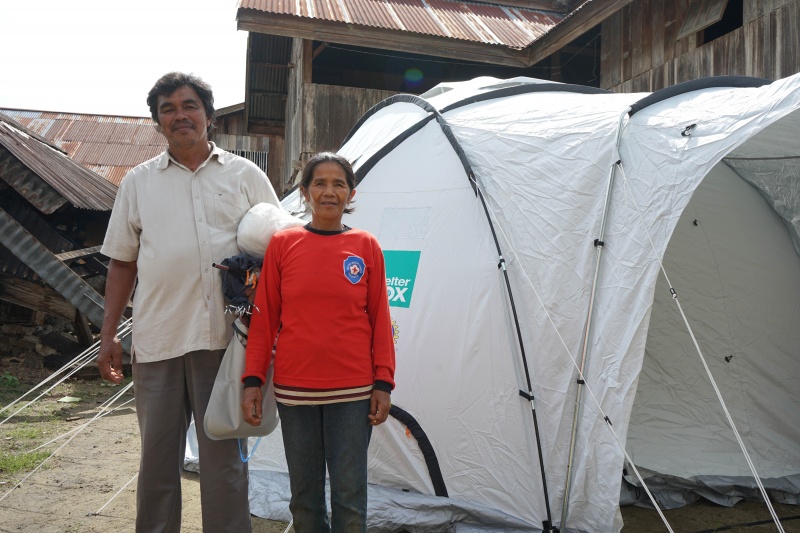
Thanks to our supporters, families have received a large sturdy tent (with space for a whole family to be together, sleep and feel safe), a water filter to make sure they have safe drinking water, two water carriers so freshly cleaned water can stay clean, and mosquito nets to protect the whole family from insect-borne diseases.
This response in Indonesia was not possible without the help of local Rotary contacts on the ground in Indonesia. With their help teams were able to coordinate with national and local government authorities to ensure we provided the right items that affected families need, and to ensure we reached vulnerable families who would not get support otherwise.
[InlineButton link=”/donate/now” title=”Support Our Work”]
Aid in Action
ShelterBox does not stop until vulnerable families have the aid they need.
Many aid agencies have been unable to respond in Indonesia due to government restrictions and other complications, but thanks to our local Rotary contacts on the ground in Indonesia ShelterBox has continued to work to get your aid to those who need it most. Right now, a ShelterBox Response Team is on the ground in Indonesia working to help survivors. We are working with the Indonesian Government and Rotary, who are helping in our mission to help the vulnerable families who will not otherwise receive aid.
Our Rotary partners in Indonesia have also been vital to understanding the needs of the affected communities, and we hope to help families in outlying areas that would otherwise get left behind. These families need a safe place to sleep together and a safe place to be together. Large, sturdy ShelterBox tents will provide families with long-lasting and weatherproof shelter to families whose homes have been destroyed. Insect-borne diseases are also a large risk for families right now – but mosquito netting will provide them with the safety and protection they need. Drinking water supplies are also very low as many water sources have been contaminated. Providing families with water-carriers and water filters will allow them access to safe drinking water (up to 1000litres!).
Learn more about these aid items here [InlineButton link=”/aid/explore-aid/” title=”Explore our Aid”]
Past Responses
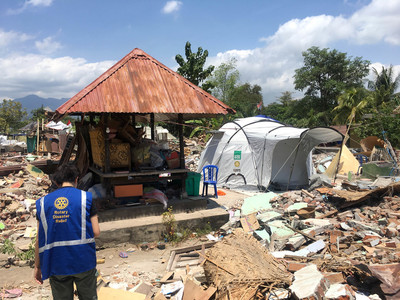
This is the latest in a series of earthquakes to hit Indonesia.
We already have a ShelterBox team on the island of Lombok, helping families recover from the 6.9 magnitude earthquake which hit in August.
The team is working with our local Rotary contacts to deliver aid to families in Lombok who lost everything in the quakes. So far we have helped over 650 families across North and West Lombok.
In addition to providing tents, tarpaulins, ropes, kitchen sets, blankets, ground sheets, mosquito nets, and solar lights, we have also provided tents to maternity and postnatal clinics.
Now, in the aftermath of the earthquake and tsunami in Sulawesi, we are hoping to help many more families. An initial ShelterBox Response Team of three people has been deployed to understand how we might be able to help Sulawesi families. Aid items such as tents, tarps, and water filters are listed as the most needed items in the affected areas. Communications are ongoing with local Rotary contacts on the ground as well as governments to ensure the right aid gets to those in need.
Where are Sulawesi and Lombok
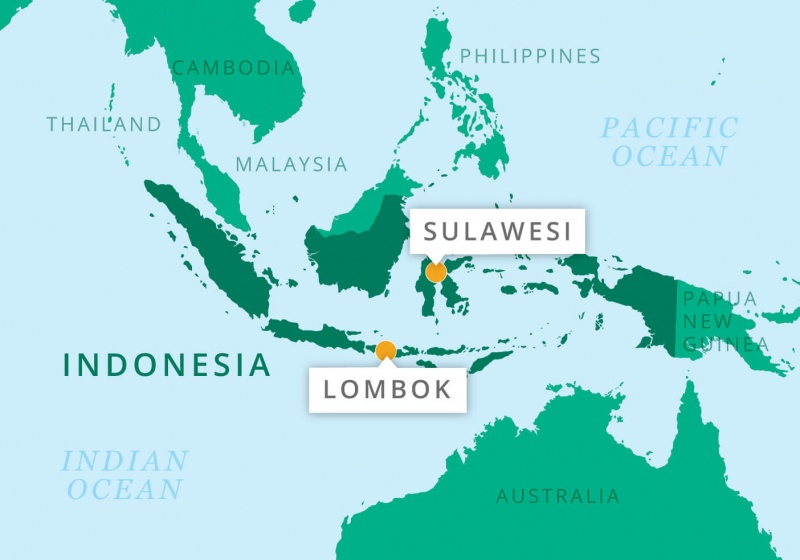
Sulawesi is one of the main islands in Indonesia. It sits between Borneo and the Maluku islands. It’s known for its coral reefs and beautiful dive sites.
The island of Lombok, where we’re responding to a series of earthquakes that hit in August, is situated to the east of Bali on the other side of the Lombok Strait. The capital, and largest city on the island, is Mataram.
Both Sulawesi and are Lombok are popular tourist destinations. But whilst tourists are able to evacuate, thousands of local families have nothing left and are in urgent need of shelter.
Tsunamis 101
WHAT IS A TSUNAMI?
A tsunami is a series of large often catastrophic ocean waves. Tsunamis should not be confused with Tidal Waves, these are waves generated on the surface of the ocean by wind, tidal pull from the moon and the position of the earth.
WHY DO TSUNAMIS HAPPEN?
The large waves that form a tsunami happen when there is an earthquake under the ocean. Other things can make tsunamis too, such as volcanic eruptions, sub-marine rockslides or a large impact in the water from an asteroid or meteor.
Water will move in all directions from the location of the disturbance, starting small and gradually getting larger and larger.
WHAT ARE THE EFFECTS?
When waves caused by the underwater disturbance reach land, they will be far faster and more powerful than regular ones. They also grow in size as they approach the shallow waters near land.
These large, powerful waves can destroy buildings, roads, railways, and pretty much anything else in their path. Tsunamis can destroy whole communities leaving many people homeless and destroying their livelihoods.
Clean drinking water will be contaminated and individuals affected often lose their possessions.
Earthquakes 101
WHAT IS AN EARTHQUAKE?
An earthquake happens when pieces of the earth’s surface rub together, causing the ground to shake.
WHY DO EARTHQUAKES HAPPEN?
Although the ground we walk on may seem solid, it is actually made of huge pieces of flat rock which together, create a kind of patchwork.
These flat pieces of rock are called plates and are constantly moving, although this usually happens so slowly we don’t even notice.
Sometimes these plates get stuck and pressure builds up until one of the plates is forced to give way – this can cause the ground across a wide area to vibrate violently.
WHAT ARE THE EFFECTS?
The size of an earthquake is usually measured by a system called the ‘Richter Scale’. Earthquakes that measure below 4 on this scale are unlikely to cause any damage and those below 2 will usually not even be felt.
However, earthquakes above 5 on the Richter Scale will cause damage and those above 7 are considered major earthquakes. These larger earthquakes can result in buildings being destroyed or so badly damaged they are too dangerous to live in.
WHAT ARE AFTERSHOCKS?
Aftershocks are earthquakes that follow the largest shock of an earthquake sequence.
They are smaller than the initial, main earthquakes and within 1-2 rupture lengths distance from the mainshock.
Aftershocks can continue over a period of weeks, months, or even years. In general, the larger the mainshock, the larger and more numerous the aftershocks, and the longer they will continue.
WHAT IS LIQUEFACTION?
Liquefaction is a phenomenon which causes sand and soil to act like a liquid when shaken by an earthquake. It tends to happen in places with loose saturated soil, like Palu in Indonesia.
The earthquake reduces the strength of the soil and it starts to flow like a liquid, lifting and carrying homes and buildings along with it. The effects can be devastating.
See where we are working
We support the most remote communities across the world that have been affected by disaster.
We go the extra mile to find the most vulnerable families whose lives have been devastated by disaster. Our work isn’t done until no family is left without shelter.

